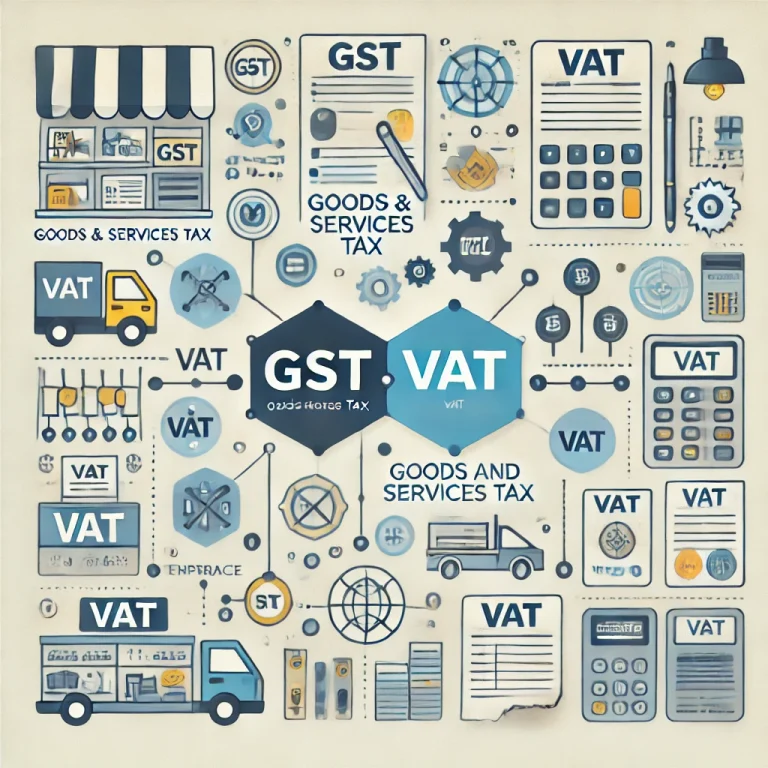GST and VAT are two indirect taxes levied on the consumption of goods and services in various countries. Both tax regimes aim to collect revenue at various levels in the supply chain, but function and influence the economy in different ways. In the paper, we discuss the main differences between VAT and GST, the mechanics of each tax specifically, and the context in which they are used.
What is Value Added Tax (VAT)?
VAT is the indirect tax levied on sales of goods and services through the addition of tax at each level of production and distribution. It is mainly practiced in the European Union, as well as in other regions. VAT forms an added layer of taxation each time value is added to a product, enabling it to tax each level of the production chain.
Mechanics of VAT
VAT operates on the principle of tax at every point of value addition. Here’s a breakdown of how VAT functions:
- Multi-Stage Tax: VAT is charged at each stage of the supply chain, from manufacturing to final sale.
- Tax Credit System: Businesses can claim input tax credits, allowing them to deduct the VAT they paid on inputs from the VAT they collected on outputs.
- End Consumer Liability: Ultimately, the tax burden falls on the final consumer as they do not have any mechanism to claim VAT credits.
For example, if a manufacturer buys raw materials, they pay VAT on those inputs. When they sell the finished product, they collect VAT on the sale price, but they can deduct the VAT paid on the inputs. This system continues until the final sale to the consumer, who pays VAT without any credit system.
Key Features of VAT
- Incremental Taxation: Levied at each stage of value addition.
- Input Credit System: Allows deduction of tax paid on inputs.
- Final Burden on Consumers: Only end consumers bear the final VAT burden, while businesses are reimbursed through the credit system.
What is Goods and Services Tax (GST)?
Goods and Services Tax is one form of a unified tax structure in which various indirect taxes are incorporated into a single umbrella. This is generally used as a single national tax like India, Australia, and Canada. It tries to make the tax structure less complicated by eradicating overlapping taxes with higher transparency.
Mechanics of GST
GST is structured as a destination-based tax, which means it is levied at the point of consumption rather than the point of production.
- Unified Tax System: Replaces several central and state taxes with one cohesive tax.
- Destination-Based Taxation: Tax is levied where goods or services are consumed, ensuring uniformity across regions.
- Seamless Input Tax Credit: The GST framework enables input tax credits, which means taxes paid on inputs can be claimed as credits, minimizing the cascading effect of tax on tax.
For example, in a country like India, GST is categorized into CGST (Central GST), SGST (State GST), and IGST (Integrated GST). This categorization ensures that both central and state governments receive their share of tax revenue.
Key Features of GST
- Single Tax Framework: Unifies multiple taxes under one tax system.
- Elimination of Cascading Tax: Credits for input tax payments avoid double taxation.
- Tax Transparency: Promotes ease of compliance and reduces tax evasion.
Difference Between VAT and GST
While VAT and GST serve similar purposes in revenue generation, the specific structure and application of these taxes diverge in notable ways. Below, we’ll discuss the major distinctions in a tabular format for easy comparison.
| Feature | VAT | GST |
|---|---|---|
| Definition | Indirect tax on the value added at each production and distribution stage. | Comprehensive indirect tax on goods and services, levied at the point of sale. |
| Taxation Type | Multi-stage tax, with tax levied at every point of value addition. | Unified tax with single points of taxation, focusing on final consumption. |
| Input Tax Credit | Available on taxes paid at previous stages. | Seamless input credit across the supply chain, minimizing cascading effect. |
| Implementation | Separate VAT laws and rates may vary by state or region. | Uniform tax structure across all states or regions in most countries with GST. |
| Cascading Effect | Potential cascading due to different tax rates and limited credits. | Eliminates cascading with a uniform credit system. |
| Tax Collection Point | Levied at multiple points throughout production. | Levied at the final point of sale, as a destination-based tax. |
| Examples of Use | European Union, United Kingdom. | India, Australia, Canada. |
1. Nature of Tax
VAT is a multi-stage tax, whereas GST is integrated single, uniform tax. VAT applies the tax several times up and down the chain of production and distribution chain, hence multiple layers of taxation. GST integrates multiple taxes into one and this is levied only once at the time of final consumption.
2. Tax Credit Mechanism
Tax credit mechanism works differently under both systems. While input credits are claimed under the VAT system, due to the limitations in a specific transaction type, specifically when there are cross-border dealings, the credit opportunity in these transactions may be severely restricted. In contrast, GST provides an unrestricted and seamless input credit scheme that allows for tax on inputs to be offset by output tax and helps establish a clear, non-cascading tax structure.
3. Cascading Effect
One of the strong reasons for adopting GST in several countries has been to get rid of the cascading effect inherent in VAT systems. Multiple tax points in VAT can result in situations of tax on tax which increases the cost of goods. GST removes this issue by having a structured input tax credit that decreases double taxation.
Considerable Difference: VAT vs GST
GST and VAT are two types of indirect taxation levied on the revenues raised from sales of goods and services, but in practice, they are very different in their composition and application. It is evident that while there is a multi-stage taxation structure in VAT with possible cascading effects, it is entirely different in the case of GST, with the use of a streamlined destination-based model that does not contain any cascading effects. In general, countries adopting GST enjoy the advantages of a clear system that is also effective while its complexity may make the business compliance task tough and challenging to achieve under a VAT regime. The choice of either of the systems depends largely on a country’s overall economic priorities, its administrative capacity, and its need for tax efficiency.
GST and VAT FAQs
What is the main advantage of GST over VAT?
GST reduces the cascading tax effect, offers seamless input tax credit, and simplifies compliance by unifying multiple taxes under a single framework.
Can VAT and GST coexist?
Generally, VAT and GST are not applied simultaneously within the same jurisdiction. However, VAT may be used in countries where GST is not yet adopted.
Is GST always applied as a single tax?
While GST is unified, some countries implement it as separate components, such as CGST and SGST in India, to ensure revenue distribution between central and regional governments.
How does VAT affect end consumers compared to GST?
Both VAT and GST are ultimately borne by the end consumer. However, GST’s seamless input tax credit often reduces the final tax amount, making goods slightly less costly than under VAT.
Are VAT and GST rates the same?
No, VAT and GST rates differ significantly across regions and product categories. Rates depend on each country’s revenue goals and economic structure.


